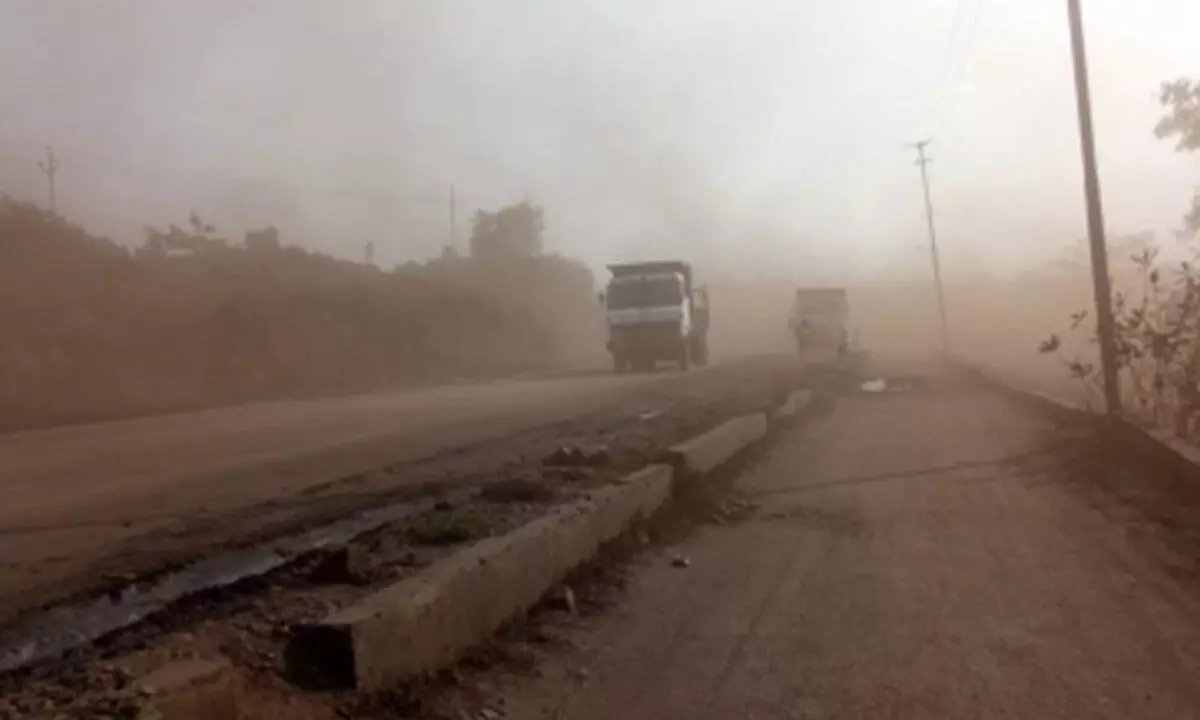Live
- SC to hear CM Kejriwal's plea against ED arrest on Monday
- Ayurvedic medicines seized in Telangana over misleading ads
- Ballia SP candidate booked for spreading hatred, threatening official
- Brother-sister want to take away property & mangalsutra for their vote bank, won’t allow it, says PM Modi
- Citizens of Bengaluru, why are you so indifferent to exercise your right to vote?
- Ad-free movies in theatres?
- Warangal: Nataraja in the eye of a needle
- Stray cattle menace key poll issue for farmers in western UP
- Warangal: BJP dividing the nation on communal lines says Srihari
- Khammam: BJP leader asserts Vinod will secure big majority
Just In
As Patna's AQI reaches 'severe' zone, doctors caution people with morbidities

With the temperature dipping in Bihar, people in the major cities are dealing with the challenges of rising air pollution.
Patna: With the temperature dipping in Bihar, people in the major cities are dealing with the challenges of rising air pollution.
The Air Quality Index (AQI) of cities like Patna went into the severe zone as the Bihar State Pollution Control Board registered 301 AQI US on Friday morning. Alarmingly, the PM 2.5 is 167 but PM 10 has reached 392 per cubic meter.
Officials claimed that construction of the Patna metro, flyovers, buildings, and transportation of sand and clay are responsible for increasing PM 2.5 and PM 10 in the city and these are contributing to the deterioration of AQI in the city.
Patna has several places like Saguna Mor, Patna bypass, Freser Road, Ashok Rajpath and other places where metro projects are underway. Besides, construction of high rise apartments is also taking place on the outskirts of the city. The transportation of sand on the streets and heavy traffic of petrol and diesel vehicles is generating toxic gases in the air in Patna.
An official of the Patna Municipal Corporation said that the department has directed the construction companies and agencies to sprinkle water on the roads in a bid to minimize fine particles mixing with the air. We have also arranged vehicles for sprinkling water on the road, still, there is a surge of fine particles mixing 5 times more in the air, the official added.
“Keeping in view the increasing AQI index, we are using anti smog guns and water sprinkling guns in the cities. The Patna Municipal Corporation has 12 mobile anti smog guns and 13 water sprinkling guns operating here. We have directed the operators to use these machines for at least 4 hours in two shifts in every circle of the state capital,” said Animesh Parashar, commissioner of the Patna Municipal Corporation.
“As the wind speed also increased in the city, it allowed dust to mix in the air. We are sprinkling water on the roads as well as on trees and pedestrian paths to check this,” Parashar said.
The situation in Muzaffarpur, Saharsa and Bhagalpur is also miserable. The AQI US in Muzaffarpur is 212 which is considered unhealthy. Besides PM2.5 and PM 10 are 128 and 244 cubic meter.
In Saharsa, the AQI US is 204 and PM 2.5 and PM 10 respectively are 151 and 262. These are unhealthy conditions for people especially those having heart related ailments and asthmatic patients.
“With the AQI index having breached the 300 mark, it is extremely dangerous for heart, bronchitis and asthmatic patients. The asthmatic patients need to take more precautions every time they step out of the house. People need to wear masks and regularly drink water,” said Dr Sanjay Vashistha, a Patna based ENT specialist.
Garima Choudhary, a resident of Kankar Bagh in Patna said: “With the AQI deteriorating in Patna, the role of the traffic police has become more crucial here. The drivers of three-wheelers used to block roads at every intersection. This led to traffic snarls. It generates more toxic gases in the air which deteriorate the AQI. The traffic department needs to take stringent action against the violators. This would help to reduce the AQI.”
"We are seeing hectic construction of roads, buildings and the metro in the city. They are breaching the basic norms of not sprinkling water on the roads or covering the under construction areas. As a result, dust amalgamates with drops of dew and forms smog, said Rajesh Tiwari, a Patna based environmentalist.
"The roads of Patna and other districts are not wider as compared to the metro cities. Hence, the traffic movement is slow here which generates more toxic gases. We are witnessing a mixture of toxic gases, dust and dew in the atmosphere. It is also the session of Diwali when bursting crackers will worsen the situation. If the law enforcement agencies do not take action against the violators, the AQI may reach the 450 mark," Tiwari said.
AQI from 0 to 50 is considered good, from 51 to 100 as moderate, from 101 to 150 as unhealthy for sensitive groups, from 151 to 200 as unhealthy for all groups, from 201 to 300 very unhealthy, from 301 to 400 severe and from 401 to 500 as hazardous for human health.

© 2024 Hyderabad Media House Limited/The Hans India. All rights reserved. Powered by hocalwire.com






